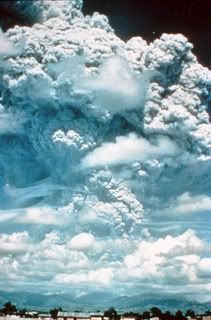Climate change and geoengineering: emulating volcanic eruption too risky
 Global warming occurs when greenhouse gases, such as carbon dioxide from burning fossil fuels, build up in the atmosphere and alter outgoing longwave radiation. Scientists have proposed different 'geoengineering' options to tackle the problem, in case governments, industry and citizens do not succeed in reducing their greenhouse gas emissions.
Global warming occurs when greenhouse gases, such as carbon dioxide from burning fossil fuels, build up in the atmosphere and alter outgoing longwave radiation. Scientists have proposed different 'geoengineering' options to tackle the problem, in case governments, industry and citizens do not succeed in reducing their greenhouse gas emissions.Some of the proposals include: seeding the oceans with iron to ensure that algae sequester carbon dioxide which would then drop to the bottom of the ocean (earlier post), creating artificial clouds that reflect sunlight back into the atmosphere and lead to global cooling, planting 'synthetic trees' that suck up CO2 and sequester it deeply in the ground (more here), or launching billions of tiny mirrors into space to prevent sunlight from reaching the planet.
The most controversial proposal is the suggestion that mitigating global warming could be accomplished by emulating a volcanic eruption because volcanic aerosols scatter incoming sunlight, reducing outgoing radiation. Rockets full of sulphur particles would be launched into the upper atmosphere and envelop the earth in a blanket of aerosols. (In an actual volcanic eruption, sulphur dioxide gas reacts with water vapor to form sulphuric acid droplets, which act like a mirror).
Many of these options have been dismissed by other scientists who have shown that the risks may be too great (previous post), or that the science is not sound (e.g. algae and iron seeding). Moreover, more feasible and far less risky geoengineering options exist, particularly those based on 'Bioenergy with Carbon Storage' (earlier post).
The proposal to imitate a volcanic eruption is the latest to come under scrutiny. Kevin E. Trenberth and Aiguo Dai of the National Center for Atmospheric Research, Boulder Colorado, caution against this mitigation proposal in a paper published in the latest edition of Geophysical Research Letters.
Trenberth and Dai's warning is based on their study of the effects of large volcanic eruptions on precipitation levels. In their study, they examine precipitation and streamflow records from 1950 to 2004 to document the effects of eruptions from Mexico's El Chichón (1982) and the Philippines’ Pinatubo (1991). They took changes from the El Niño-Southern Oscillation into account:
 energy :: sustainability :: biomass :: bioenergy :: bio-energy with carbon storage :: climate change :: geoengineering :: sulphur :: volcanic eruption :: atmosphere :: precipitation ::
energy :: sustainability :: biomass :: bioenergy :: bio-energy with carbon storage :: climate change :: geoengineering :: sulphur :: volcanic eruption :: atmosphere :: precipitation :: The scientists find that, following the 1991 eruption of Mount Pinatubo, there was a substantial global decrease in precipitation over land, a record decrease in runoff and river discharge into the oceans, and widespread drying over land during the following year.
Thus, the authors conclude that major adverse effects, including drought, could arise from this type of geoengineering solutions to global warming.
Picture: June, 1991, the cataclysmic eruption of Mt. Pinatubo in the Philippines released around 20 million tons of sulfur dioxide into the atmosphere. The explosive eruption's effects continue to this day.
References:
Kevin E. Trenberth and Aiguo Dai, "Effects of Mount Pinatubo volcanic eruption on the hydrological cycle as an analog of geoengineering", Geophysical Research Letters Vol. 34, 2007, DOI: 10.1029/2007GL030524.
Biopact: Simulation shows geoengineering is very risky - June 05, 2007
Biopact: WWF condemns Planktos Inc. iron-seeding plan in the Galapagos - June 27, 2007
Biopact: The end of a utopian idea: iron-seeding the oceans to capture carbon won't work - April 26, 2007
Biopact: Capturing carbon with "synthetic trees" or with the real thing? - February 20, 2007
Biopact: Abrupt Climate Change and geo-engineering the planet with carbon-negative bioenergy - December 21, 2006
 --------------
--------------
 Taiwan's Feng Chia University has succeeded in boosting the production of hydrogen from biomass to 15 liters per hour, one of the world's highest biohydrogen production rates, a researcher at the university said Friday. The research team managed to produce hydrogen and carbon dioxide (which can be captured and stored) from the fermentation of different strains of anaerobes in a sugar cane-based liquefied mixture. The highest yield was obtained by the Clostridium bacterium.
Taiwan's Feng Chia University has succeeded in boosting the production of hydrogen from biomass to 15 liters per hour, one of the world's highest biohydrogen production rates, a researcher at the university said Friday. The research team managed to produce hydrogen and carbon dioxide (which can be captured and stored) from the fermentation of different strains of anaerobes in a sugar cane-based liquefied mixture. The highest yield was obtained by the Clostridium bacterium.








1 Comments:
Thus, the authors conclude that major adverse effects, including drought, could arise from this type of geoengineering solutions to global warming.
Post a Comment
Links to this post:
Create a Link
<< Home